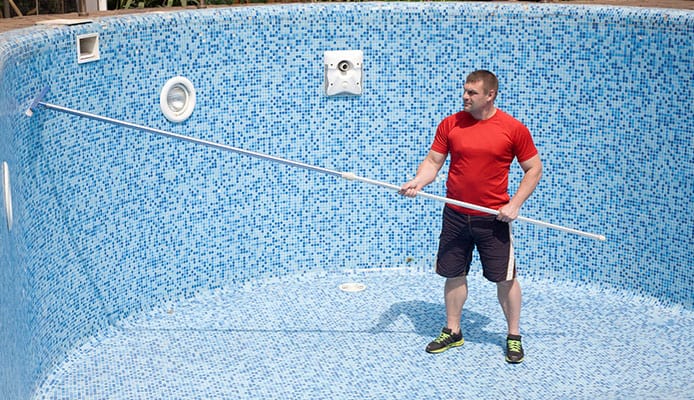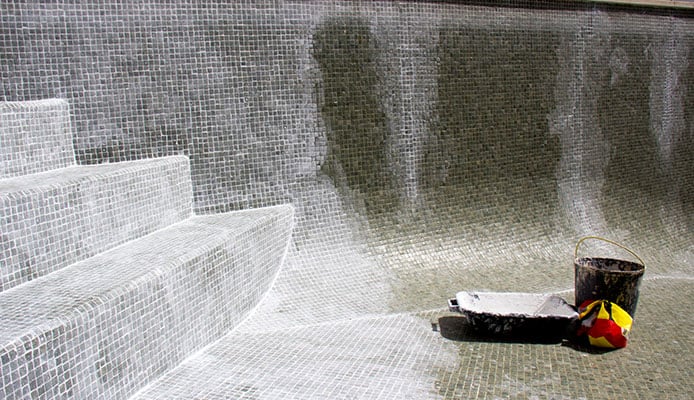
A clean and hygienic pool goes beyond having crystal clear waters and balanced water chemistry; you also need to have clean and dirt free pool tiles. But if you’ve owned a pool long enough, you’d know that keeping your pool tiles clean can be a challenge. And even more challenging is how to clean pool tiles and remove the dirt and residue buildup on them, especially at the waterline. Fortunately, there are various ways to get rid of dirt buildup and make your pool tiles squeaky clean again.
Blasting
One of the most recommended ways of cleaning pool tiles is blasting. There are three types of blasting methods that can be applied, namely glass bead blasting, salt blasting, and soda blasting.
Glass Bead Blasting
Glass bead blasting makes use of ultra-fine rounded glass beads that are as tiny as the tip of the needle. Because of their minute size and round shape, you can have your pool tiles blasted without having to worry about the glass scratching your beautiful pool tiles.
Another advantage of glass bead blasting is that it doesn’t make use of any harsh pool cleaning chemicals. As such, you don’t have to worry about acids or other agents mixing with your pool water. Also, glass bead blasting equipment is reusable, making it a great investment for pool owners. If you’re worried about the glass particles hurting anyone in the pool, then don’t be because they are pretty easy to clean and since they’re rounded they won’t cause any cuts even if you step on them. This doesn’t mean that you can leave them lying around of course; you still need to clean up after using them.
Salt Blasting
As opposed to glass bead blasting which makes use of tiny glass beads, salt blasting makes use of, well, salt. But it’s not your ordinary table salt though, mind you. The salt used for this purpose is Kieserite, a natural mineral salt. When the salt is blasted onto the tiles that are affected by the dirt buildup, the salt bursts and loosens the dirt from the tiles’ surfaces. There are several advantages to using this type of blasting to clean your pool tiles.
For one, this is a great method to use for sandstone, ceramic, and most other types of tiles. But more importantly, people prefer this blasting method because it uses salt which is a biodegradable item and has neutral pH. Thus, many pool owners consider it as the safest way to clean pool tiles.
Soda Blasting
The third blasting method is soda blasting which makes use of sodium bicarbonate or baking soda. Compared to glass beads and salt, baking soda is a much gentler cleaning agent, but this does not mean that it is less effective. However, if you choose to use this blasting technique, you should be aware that baking soda generally has a pH level of 8.3 which is high enough to increase the pH and alkalinity levels of your swimming pool.
Manual Cleaning
If you don’t want to spend tons of cash on blasting services, then you can clean your pool tiles manually. In some cases, a tough nylon brush with some household cleaning agents like vinegar or baking soda should be enough to get the job done. However, for the more stubborn calcium buildup and residues, you’re going to need some special cleaning equipment and solutions.
That said, you may want to visit your local pool supply store and ask about the different cleaning equipment and solutions available. They should be able to provide you with pool scrubbing blocks like a pumice stone. They may also be able to recommend the best cleaning agent or pool acid for you.
Make the Tile Accessible for Cleaning
The first thing you’ll want to do is to expose the waterline tiles. In many cases, you’ll need to drain some of your pool’s water until all of the perimeter tiles are clearly exposed. To do this, you can set your pump filer to a ‘backwash’ setting and let the water drain away until it goes just a tad below the bottom of the waterline tiles. Once the tiles are exposed, you can start to clean them.
Keep in mind though that you don’t want to drain too much water. This is because you’re going to need the pool water to be close to the tiles for the actual cleaning process.
Mild cleaning
If the dirt and residue in the waterline are minimal, then you can use a nylon brush to scrub them off. You can also use ordinary household or natural cleaning solutions like baking soda or vinegar to help make the cleaning process easier. Using these will certainly help you avoid spending money on chemical cleaners.
So first, you’ll want to spray the tile you want to clean with pure vinegar using a spray bottle. Let it sit there for at least five minutes before scrubbing the dirt and residue. Rinse the tile with pool water and evaluate if the tile is clean enough for you. If not, repeat the process until you achieve the desired level of cleanliness. Don’t worry about the vinegar and dirt water mixing in with your pool water since this will be cleaned when you turn the pump and filtration system on.
Calcium Buildup
To get rid of hard calcium buildup, you’ll need something tougher than a nylon brush, like a pumice stone for instance. In fact, many pool owners swear by the effectiveness of pumice stone for removing calcium buildup in the waterline in their pool.
There are some things to remember though when it comes to using a pumice stone. For instance, be sure to wet the pumice stone and the tiles before you start cleaning. This will help to prevent scratches on the tiles, not that ceramic tiles will show any visible effect from the use of a pumice stone. Also, you may want to experiment first on a tile in a less exposed area of the pool just to make sure that it will not damage the tile. When using the pumice stone, grip the pumice stone firmly and use a back and forth motion to clean the tiles.
Dealing with Difficult Residue
Some residue and deposits can be tougher to clean and using a pumice stone and vinegar wouldn’t be enough to do the trick. For such residue, you may need to use a stronger cleaning agent, like a pool acid or muriatic acid for instance. Simply apply the acid to the area you need to clean and let it sit there for a few minutes. After that, you can start scrubbing it off using your pool brush. Letting the acid flow down into the pool water should be fine since a small amount wouldn’t generally affect the pool’s water chemistry. Besides, your pool water should be back to normal once you start adding in more water.
Although pool acid or muriatic acid isn’t as strong as other acids, they can still be hazardous. Inhaling the fumes which come out of the bottle when you open it can lead to respiratory problems. The same is true when you breathe in the gases which result from the chemical reaction caused by adding the acid to the residue. Using a face mask or respirator will certainly be of help in protecting you from the harmful effects of these gases.
Also, do wear a pair of gloves and goggles when using acid to clean your pool tiles. Acid (even weak ones such as pool acids) can still cause a considerable amount of pain when they splash onto your skin or eyes.
You might also like: How To Get Rid Of Water Bugs In Your Swimming Pool
Cleaning Up
Once you’re satisfied with how clean your pool tiles are, you can now start to refill the pool until the water is back to its normal level. Once the desired level is reached, run your swimming pool pump for a few hours. Afterward, you can start checking your water chemistry for balance and adjust it accordingly.
You should also start cleaning up any dirt or debris in the pool which may have been left behind by the cleaning process. For instance, check the surface of the water and make sure that no brush bristles are floating around. If you do see brush bristles, consider getting yourself a new pool brush. Look for any signs of residue that may have come off the pumice stone while you were scrubbing the tiles. If you see any, now would be a good time to run your pool vacuum.
Don’t forget to wash and rinse your cleaning equipment as well and secure the cap on any cleaning solution or acid container which you used. Be sure to store them properly to avoid any unfortunate incidents.
Globo Surf Overview
To keep your pool tiles clean, you should consider periodic maintenance cleaning. This will require effort and time, but it shouldn’t be too much of a problem if you know how to clean pool tiles. Besides, consider talking to a pool professional and have them analyze your pool water. They can help you determine why your pool tiles are getting residue and contaminants in the first place (prevention is better than cure, right?). Keeping these things in mind will certainly help a lot in keeping your pool tiles squeaky clean and make maintenance easier in the long run.
More Pool Care Guides:


